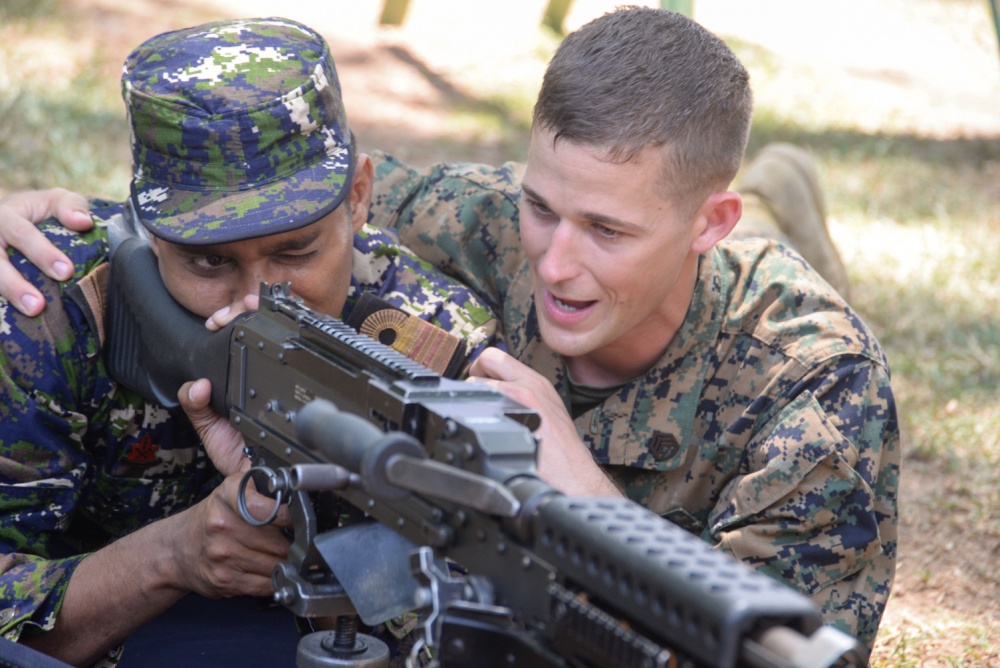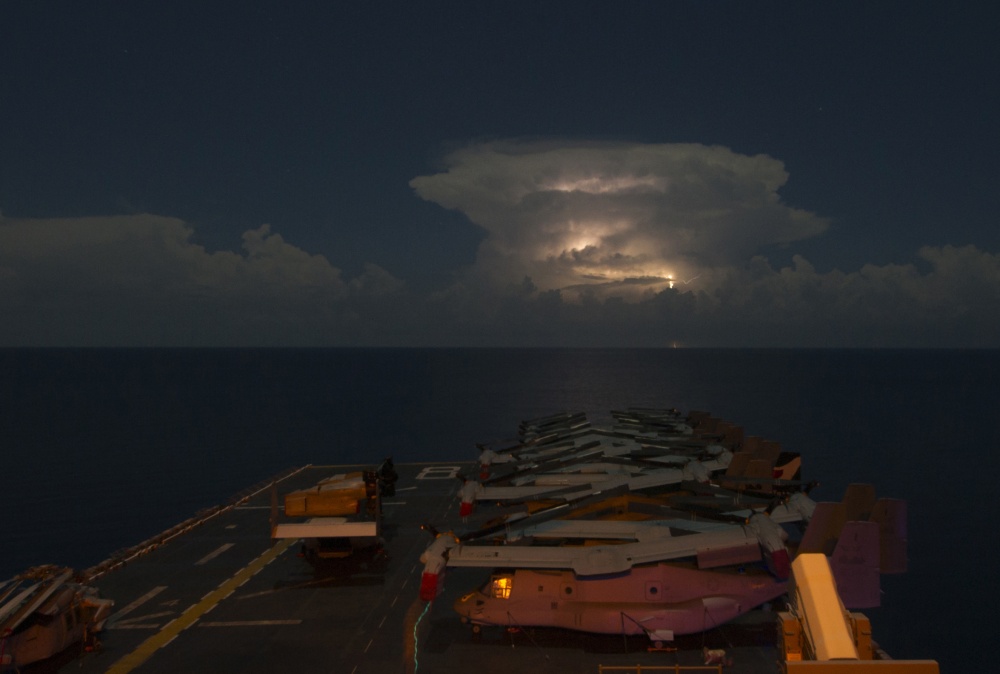December 4, 2016
Video at https://www.marinecorpstimes.com/articles/pride-of-the-pacific-trains-new-sri-lankan-marine-corps
Camp Pendleton Marines wrapped up the first official training mission with the newly created Sri Lankan marine corps last week, the latest sign of the U.S. military stepping up engagement in the Indo-Asia-Pacific region.
Sri Lanka stood up its new naval infantry this year with a core force of seven officers and 150 sailors and modeled it on the U.S. Marine Corps, its Navy announced in November.
More than 300 U.S. Marines and sailors with the 11th Marine Expeditionary Unit spent three days with Sri Lanka’s fledgling corps, teaching them basic military skills.

Staff Sgt. Austin Rice, of Fleet Antiterrorism Security Team Company Pacific, right, instructs proper use of the M240G machine gun to his Sri Lankan counterpart during bilateral training between U.S. and Sri Lanka Marines at Welisara Navy Base, Sri Lanka.Photo Credit: PO2 Jason Kofonow/Navy
The small island nation off the coast of southern India, Sri Lanka is situated along vital maritime transit routes and can play a important role in maintaining the strategic balance in the region and keep China in check.
Sri Lanka is between a rock and a hard place as India and China vie for regional dominance: historical grievances prevent Sri Lanka from getting too close to India, while aggressive Chinese expansion is seen there as a direct threat to autonomy.
“From Sri Lanka’s perspective, they are too weak to be totally independent, so their hope is to balance India and China in such a way as to not completely lose their autonomy,” explained Sarah Watson, an expert in security dynamics of the Indian Ocean at the Center for Strategic and International Studies.
The joint training with the U.S. Marines shows that Sri Lanka is emerging as a “significant contributor” to security of the “maritime superhighways” of the region, U.S. Pacific Command commander Navy Adm. Harry Harris Jr. said in a statement in November.
Harris was the first American four-star officer to visit Sri Lanka in nearly a decade, highlighting the increased importance of the small island nation in fighting terrorism, piracy and illegal trafficking. He spoke at the Galle Dialogue international maritime conference in Sri Lanka’s capital Colombo on Nov. 28.
“We must be also be ready to provide humanitarian assistance and disaster relief and ensure unencumbered and safe navigation in the region’s vital shipping lanes,” Harris said at the conference.
“These engagements are clear demonstrations of our commitment to Sri Lanka and to this region,” Harris said.
Humanitarian assistance and disaster relief missions will remain one of the U.S. Marine Corps’ primary functions globally as laid out in Force 2025, the service’s strategic guidance through the next decade.
Having an at-the-ready Sri Lankan marine force as a regional partner could provide vital support for the U.S. Marine Corps, which has a current force size down about 10 percent from its peak of 202,000 several years ago.
The 11th MEU Marines — known as the “Pride of the Pacific” — are currently on a pump through the Indo-Asia-Pacific region aboard the amphibious transport dock ship Somerset as part of the Makin Island Amphibious Ready Group.
They arrived at the port of Trincomalee, Sri Lanka’s strategically important, deep-water harbor, and worked intensely with the Sri Lankans on basic defensive tactics, combat lifesaving skills, explosive ordnance disposal, aircraft familiarization and small unit leadership classes. Over 150 U.S. and Sri Lankan Marines also staged several amphibious landings.

Lightning strikes the horizon as the amphibious assault ship USS Makin Island (LHD 8) operates in the U.S. 7th Fleet area of operations. Photo Credit: PO1 Larry S. Carlson/Navy
The theater security cooperation training was also an opportunity to impart to the new marine corps how U.S. Marines do business.
“Simply put, U.S. Marines are known for taking care of their own, demonstrating a bias for action and having an unwavering devotion to mission accomplishment,” Col. Clay Tipton, 11th MEU commander, said in a statement.
The new marines were initially established in early 2016 by the commander of Sri Lanka’s Navy, Vice Adm. Ravindra Wijegunaratne.
Over the summer, Wijegunaratne attended the Pacific Command Amphibious Leaders Symposium 2016 held in San Diego, California.
The gathering of military leaders focused on need for increased collaboration in the ability to project power from the sea throughout the Indo-Asia Pacific region, which U.S. Marines term “amphibiosity.”
“Anytime we can work and train with partner and allied militaries, it lays a foundation for future cooperation,” said Capt. Darren Glaser, commander officer of the Somerset.
“These engagements build the relationships and trust needed for cooperative responses to regional crises.”
The region is pummeled by tropical cyclones on a regular basis, often killing hundreds and leaving thousands homeless and displaced.
On the morning of Dec. 26, 2004, a massive tsunami left about 35,000 Sri Lankans dead, 15,000 injured and 500,000 displaced.
The operational alliance emerging between the U.S. and Sri Lanka military forces may have long-term consequences, Watson said.
“It’s a really interesting sign that the U.S. and Sri Lankan militaries are interested in being able to conduct operations together,” Watson said. “In the present situation, the most common operation they’d actually do together is disaster relief, but that lays the groundwork for possible future operations.”
“It’s hard to imagine the U.S. and Sri Lanka fighting a war together, but the more capable the Sri Lankan military is, the easier it will be for the country to be able to maintain a stand-off posture vis-à-vis its two gigantic neighbors,” she said.
Editor’s note: this article was first published Dec. 4th and has been updated to reflect input from the U.S. embassy in Colombo on the establishment of the Sri Lankan marines.
US’s most advanced ocean surveillance aircraft visits Sri Lanka

Colombo, Dec 13 (NIA) – US sailors on an advanced U.S. Maritime Patrol Aircraft, who arrived in Sri Lanka on a week long visit on Dec 4, worked with Sri Lanka Air Force and Navy in safe-guarding the international shipping lanes that are vital to global commerce, a US Embassy statement said here on Tuesday.
The “Red Lancers” of Patrol Squadron TEN (VP-10) who arrived aboard the P-8A Poseidon aircraft, also met with Sri Lanka military personnel to demonstrate the capabilities of the P-8A and exchanged expert advice.
“This bilateral partnership with Sri Lanka security forces reinforces the global maritime rules that produces greater prosperity for all of us,” said U.S. Embassy Chargé d’Affaires Robert Hilton.
The Red Lancers are stationed in Jacksonville, Florida and currently on a routine deployment to the Indo-Asia-Pacific to ensure safety and security of vital sea lanes and trade routes, including integrating air and sea patrol operations.
The P-8A is a multi-mission aircraft that provides long-range maritime patrol capabilities, making it the most advanced ocean surveillance aircraft in the world.
“We are pleased about the opportunity to partner with our friends in the Sri Lankan government and armed forces,” said Lt. Anthony Beres, the detachment officer in charge.
“The P-8A Poseidon brings advanced capabilities to maritime safety patrols, search and rescue, counter-narcotics, and humanitarian and disaster relief efforts, and we appreciated engaging with the Sri Lankan Navy during this visit.”
The Poseidon Aircraft departed from Mattala Rajapaksa International Airport in Hambantota, which was built by China on a semi-commercial loan, during the previous government. The new Sri Lankan government is currently in talks with China to get a Chinese firm to partner to run it or buy a stake.